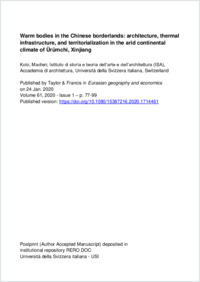Warm bodies in the Chinese borderlands : architecture, thermal infrastructure, and territorialization in the arid continental climate of Ürümchi, Xinjiang
- Kobi, Madlen Istituto di storia e teoria dell’arte e dell’architettura (ISA), Accademia di architettura, Università della Svizzera italiana, Switzerland
-
24.01.2020
Published in:
- Eurasian geography and economics. - 2020, vol. 61, no. 1, p. 77-99
English
Architectural research often considers buildings and settlement practices as local material adaptations to climate, particularly when it comes to the analysis of architecture in rural and small-scale settlements. Based on ethnographic data from the rapidly urbanizing oasis metropolis Ürümchi in China’s northwestern borderlands, this paper goes beyond such a localized view of climate responsiveness. It analyzes how individual practices of residents for the purpose of creating comfortable spaces in urban settings are linked to the interests of the state and to socio-cultural notions of thermal comfort. Through the classification of Xinjiang as part of China’s northern “Heating Zone,” the keeping warm of individual bodies becomes part of a territorializing strategy, because investments in urban thermal infrastructures and the inclusion in a national heating grid have anchored these regions within the state. There are, however, clear seasonal differences in how indoor residential spaces are regulated to maintain bodily comfort. In winter, apartment owners and residents enjoy the amenities of the state-financed heating infrastructure. In summer, cooling strategies depend on more neoliberalized, individual, social, and architectural ways to lower indoor temperatures. This paper unfolds the diversity of thermal discourses and practices that characterize Ürümchi citizens’ creation of comfortable residential spaces throughout the seasons. The data outlines that houses as infrastructures are far from being simple containers that keep residents’ bodies warm. Instead, the socio-technical organization of thermal spaces interferes with territorial strategies and ethnic place-making.
- Language
-
- English
- Classification
- Architecture
- License
-
License undefined
- Open access status
- green
- Identifiers
-
- RERO DOC 329509
- DOI 10.1080/15387216.2020.1714461
- ARK ark:/12658/srd1319347
- Persistent URL
- https://n2t.net/ark:/12658/srd1319347
Statistics
Document views: 204
File downloads:
- Texte intégral: 720
